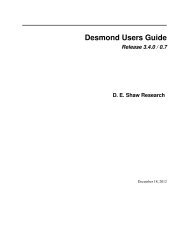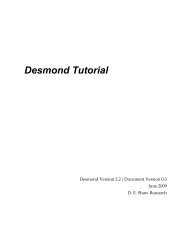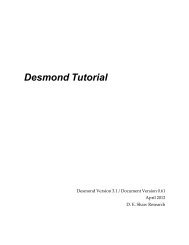Desmond Tutorial
Desmond Tutorial - DE Shaw Research
Desmond Tutorial - DE Shaw Research
- No tags were found...
Create successful ePaper yourself
Turn your PDF publications into a flip-book with our unique Google optimized e-Paper software.
7 Preparing Free Energy<br />
Perturbation<br />
Overview<br />
You can use <strong>Desmond</strong> to run free energy perturbation (FEP) calculations using the dual<br />
topology approach to perform ligand mutation, annihilation, and single‐atom mutation in<br />
a ring. From Maestro, you can visually specify the fixed and variable parts of a molecule<br />
that are subjected to FEP calculations and then store the atom correspondence map<br />
(which defines dual topologies) in the Maestro .mae file.<br />
Ligand mutation—the most common FEP calculation—is illustrated in Figure 7.1 using a<br />
typical scenario. The figure shows a graphical representation of the soluble form of the<br />
human urokinase plasminogen activator receptor (sUPAR, PDB code 2fd6) and the ZINC‐<br />
01538934 ligand. The protein structure has been processed using the Protein Preparation<br />
Wizard and Prime as described in “<strong>Tutorial</strong> Steps” on page 3 and “Running Prime” on<br />
page 29, respectively, and the ligand was docked using Schrödingerʹs Glide application as<br />
part of a virtual screening experiment on the ZINC database (http://zinc.docking.org/).<br />
The ligand is rendered in a tube representation in the sUPAR active site with green carbon<br />
atoms and ball‐and‐stick representation.<br />
September 2008 D. E. Shaw Research 69






